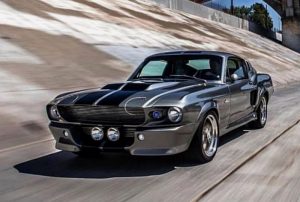One of the revelations of the Frankfurt Motor Show in September 1961,the Prinz 4 replaced the original Prinz
The Prinz 4 was the basis for the new, longer and more powerful Prinz 1000. The overall length grew by 353 mm to 3793 mm and the wheelbase grew from 2040 mm to 2250 mm. Beneficiaries were the luggage compartment up front and the cabin.

Nsu Prinz was produced in West Germany by the NSU Motorenwerke AG from 1958 to 1973
The chrome adorned wraparound shoulder line dominates from any angle and visually stretches the body longer and wider. The car’s stance gained from larger wheels and a more upright camber angle of the rear wheels. The greenhouse continued to use very thin pillars. The tapered C-pillar was now slightly more slanted than in the Prinz 4. The rear edge of the roof kept that slight overhang of the Corvair. The car’s flanks received grilles for the cooling air intake on the left and exhaust on the right. On either side the grilles were underscored by fine creases that wrapped around the rear quarters and turned into a brows above two triplets of tail light lenses.

These lenses were sometimes referred to as jelly jars owing to their shape and colors. The reversing light lenses were pointing straight down and bounced the light off the slim chrome bumper. The skirting below the bumper was sporting shallow flutes. The roof may have looked a little bit too high, however it was significantly lower than that of its competitive target the VW Beetle. Taken together these subtle details distinguished the Prinz 1000 very clear from the Prinz 4 no matter from which angle it was viewed.

At the heart of the new car is a new transversely mounted engine with 4 cylinders that consist of two cast iron twin cylinder blocks based on those found in the Prinz 4 mounted to a new crank case and capped by a single aluminum head. This head carries a single cam that actuates 8 valves by way of rocker arms. Each rocker and valve is accessible through its own cover, a feature that makes this engine very pleasing to look at. In the Prinz 1000 a single carburetor feeds the combustion mixture through a manifold into the inlets at the front. The exhaust openings are pointing towards the back. In other words it is a cross flow design.

The engine kept the clutch and blower unit at the left end of the crank shaft. The power is then send by a pair of helical gears into the fully synchronized 4 speed transmission that also houses the differential. This arrangement allows for the replacement of the clutch without removing either the transmission or the engine in about 35 minutes. The Dynastart made way to separate starter and generator.
The Prinz 1000 engine actually displaced 996 cc and was rated at 43 hp (DIN) at 5500 rpm. It provided 7.3 kgm (52.8 lb ft) of torque at 2000 rpm. Later power output was reduced to 40 hp (DIN) in order to slot the car into a less expensive insurance bracket. The drop in horsepower did not affect the top speed of 135 km/h and the 0 to 100 km/h time of 18.4 seconds.

The instrument panel carried a large round speedometer flanked by two small round dials. All the controls were close at hand. Foot space was still cramped by large intruding wheel wells. The steering column was standing rather upright therefore the wheel was reminiscent of a bus.
To better compete with the VW 1500 (Type 3) NSU released the Typ 77 which named NSU 110, NSU 1200, NSU 1200 C and 1200 Automatic. These had larger engines, first 1085 cc then 1177 cc making 53, 55, and in SC trim even 60 hp (DIN). The engines were praised for their tractability, being able to dawdle along at 2000 rpm for leisurely rides yet able to run for hours on end under full load.

The enlarged engines were then put in the NSU 1000 bodies which transformed them into veritable sport sedans called NSU 1000 TT, NSU TT and NSU TTS. These models – and the havoc they created – will be subject of Part 2 of this CC.
Total production of the NSU Prinz 1000, NSU 1000 and NSU 1000 C came to roughly 196.000 units.
From 1965 to 1967 about 74000 units of NSU Typ 110, Typ 110 S and Typ 110 SC rolled off the assembly line.
Between 1967 und 1973 about 256.000 units of the NSU 1200 and 1200 C were made.
General characteristics
Engine
Engine: Straight 4
Valve train: Single overhead camshaft
Valves: 2 valves per cylinder 8 total valves
Displacement: 1172 cc
Bore x Stroke: 75.00 mm x 66.30 mm 1.13 ratio
Compression ratio: 9.20:1
Maximum power: 65 hp @ 550 rpm
Maximum torque: 88 Nm @ 2500 rpm
Fuel: Petrol
Fuel feed: Fuel Injection
Top speed: 154km/h
Dimensions
Wheelbase: 2250 mm
Length: 3793 mm
Width: 1490 mm
Height: 1364 mm
Track front: 1255 mm / rear: 1248 mm
Kerb weight: 650 kg
Chassis and drivetrain
Engine location: Rear
Engine Alignment: Transverse
Wheel Drive: Rear wheel drive
Transmission: 4, Manual
Steering: Rack & Pinion
Turning circle: 9.50 m
Brakes front: Disc / rear: Drum
Share this:
- Click to share on Facebook (Opens in new window)
- Click to share on Twitter (Opens in new window)
- Click to print (Opens in new window)
- Click to share on LinkedIn (Opens in new window)
- Click to share on Reddit (Opens in new window)
- Click to share on Tumblr (Opens in new window)
- Click to share on Pinterest (Opens in new window)
- Click to share on Pocket (Opens in new window)
- Click to share on Telegram (Opens in new window)
- Click to share on WhatsApp (Opens in new window)




